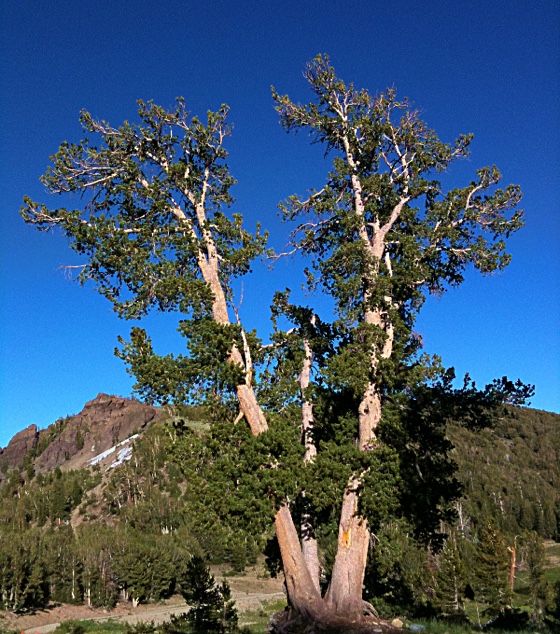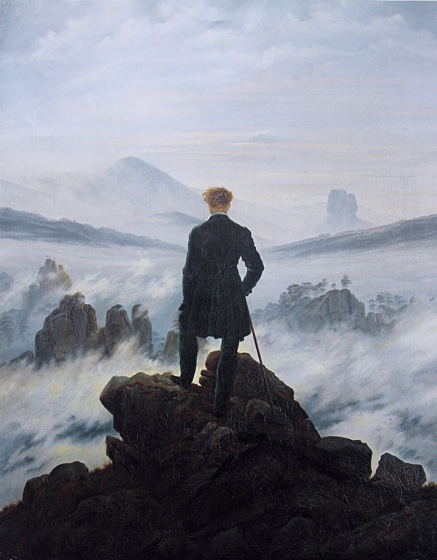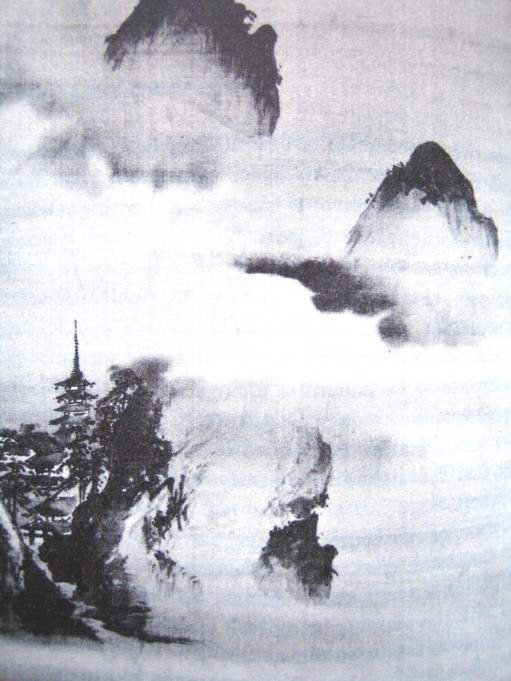
Across centuries and continents, mountains are major sources of meaning—of inspiration and insight—for human beings. Why is that?
The color scheme of this web site—cobalt blue, dark green, and golden brown—was inspired by the tree in the photograph above. It stands on a desert mountain, ten thousand feet above sea level, within walking distance of my home. It is highly meaningful—to me.
I love mountains; I live and walk among them when I can.
I don’t know why mountains matter. Many reasons, maybe. This metablog post collects some observations and speculations.
The Mountain: a view from hell yes

I was inspired to write this by “The Mountain,” a recent post by Sarah Perry on her blog The View From Hell [Yes]: the search for patterns and the thickening of meaning. She thinks and writes, brilliantly, about many of the same topics I do.
She points out that among William James’ collection of others’ accounts of mystical experiences, many occurred in mountains. For instance:
I have on a number of occasions felt that I had enjoyed a period of intimate communion with the divine. These meetings came unasked and unexpected, and seemed to consist merely in the temporary obliteration of the conventionalities which usually surround and cover my life…. Once it was when from the summit of a high mountain I looked over a gashed and corrugated landscape extending to a long convex of ocean that ascended to the horizon, and again from the same point when I could see nothing beneath me but a boundless expanse of white cloud, on the blown surface of which a few high peaks, including the one I was on, seemed plunging about as if they were dragging their anchors. What I felt on these occasions was a temporary loss of my own identity, accompanied by an illumination which revealed to me a deeper significance than I had been wont to attach to life.1
This was written by a Christian, but sounds quite Zen, or perhaps Taoist.2
The Great Image Has No Form

Will Buckingham, another of my favorite thinker-writers, has recommended and reflected on a remarkable book: François Jullien’s The Great Image Has No Form, or On the Nonobject through Painting. It is about cloudiness, both as reality and metaphor for non-object-ness, expressed in Chinese painting and Chinese philosophy. It is:
about vagueness, about that which is indistinct, about the mist and fog that swirls through Chinese painting, about the mountains that simultaneously arise out of, and are dissolved into, the cloud.
Nebulosity (literally “cloudiness”) is the first concept of Meaningness. Second, my book examines the nebulosity of boundaries. Two confused stances deny that nebulosity: monism, which says “All Is One,” and dualism, which says that the world consists of clearly distinct objects.3 Meaningness then considers the nebulosity of the self/other boundary specifically. Two confused stances deny that nebulosity. True self hardens the self-other boundary, as in the dualist conception of the soul. Selflessness rejects the self as harmful, or rejects the distinction between self and other. Selfless attitudes are typical of ascetic philosophies, such as most traditional Buddhism.
Self and other are never either perfectly distinct nor perfectly unified; and so the self is not such a problem. Buckingham quotes Jullien:
The Zhuangzi teaches us to de-occupy ourselves, but not because the “self” is detestable and we must flee it or ascetically deny it, but because we need to recover from the consistency of the subject, to rid ourselves of it and “forget” it, in the terms of the Zhuangzi… in such a way that we no longer have to posit the world as an object opposite us, to be known and manipulated.
Mystical mountaintop revelations often involve “a temporary loss of one’s own identity, accompanied by an illumination which reveals a deeper significance.” But that identity was never more than a “conventionality”; a taken-for-granted idea that does not accurately represent typical felt experience—if we bothered to check. Buckingham writes that
the deeply strange German philosopher, Franz Rosenzweig, suggests that most of the time our experience is simply not that of being a subject, separated off from the world, confronting a world of objects that is opposite us. We only become a subject (“I”) looking at an object (“a tree”, perhaps) when somebody says “what are you up to?” and we say, “Oh, I’m looking at a tree…”
This is not a mountain-shaking mystical epiphany, no peak experience, but quite ordinary. That is a major theme in Martin Heidegger’s Being and Time, a work that Buckingham, Perry, and I all cite as formative inspiration for our thinking.4
Heidegger’s example is a carpenter using a hammer.
We achieve our closest relationship with a hammer not by looking at it, or by some detached theoretical study of it, but by manipulating it. While engaged in trouble-free hammering, the skilled carpenter has no conscious recognition of the hammer, the nails, or the work-bench, as independent objects, in the way that one would if one simply stood back and thought about them.
Moreover, not only is the hammer not part of the engaged carpenter’s world, neither is the carpenter. The carpenter becomes so absorbed in his activity that he has no awareness of himself as a subject over and against a world of objects. There are no subjects and no objects; there is only the experience of the ongoing task (e.g., hammering).5
It is not that “the boundary between self and other breaks down”; it is that the distinction is irrelevant and useless here. So it is no more present than the boundary between Ohio and Kentucky, or between reptiles and amphibians.
Flow, on and off the path
Perry’s post describes running on specific mountain paths in Los Angeles. Of one, she writes:
I find it very difficult not to stick my arms out airplane-style on this part of the run, out of pure joy…. The descent begins gently, but quickly gets steep, so that maintaining a running pace requires full concentration, frequently producing the mental state known as “flow.” It is the most thrilling part of the run, resembling what I imagine to be the experience of steering a Star Wars air motorcycle through the forest.
Mountain running is, for me also, one of the most reliable ways to induce flow. It requires extended physical exertion, close proprioceptive attention to the workings of one’s own body and to the irregularity of the ground, rhythmic movement, and enjoyment of natural beauty. All contribute to the flow state, which is quite like Heidegger’s description of expert hammering. Flow is non-conceptual, but not a state of mindless automatism; rather, of heightened awareness.6
I’ve written about the connections between flow and Buddhist Tantric ritual:
“Flow” occurs when you are totally immersed in an activity that consumes your full attention and skill. It’s described by athletes as being “in the zone,” and by musicians as being “in the groove.” It’s highly enjoyable; often the best thing in life.
Flow is closely related to Buddhist Tantra; but there are important differences. These help explain the “path” aspect, or methods, of tantra.
Elsewhere, I wrote:
Spiritual paths are not much like the paths in a garden or city park. Instead, I want to compare them with hiking trails in remote, rugged mountains. The terrain of religious experience can sometimes be uncertain, difficult, or even dangerous, making this an apt analogy.
Being on a path can put you in the groove. I find mountain hiking most interesting when I’m off the path, though. This is also a valuable metaphor for more difficult explorations of meaningness. I’ve written about that here and here. I’d like to say more now, but it would risk our getting lost…7
Vastness
Mountains are big. Bigger mountains are better; more meaningful.
The sky is big. It is bigger in the mountains. You can see, in the photo at the head of this page, how at ten thousand feet the thinner atmosphere makes the sky darker blue.
Experiencing vastness often transforms into an intense experience of religious meaningfulness. I do not know why. No one can say what the meaning is.
The emperor of China asked Bodhidharma, the founder of Zen: “What is the first principle of the holy truth?”8
Bodhidharma replied:
No holiness —
Vastness!
The emperor did not understand. So Bodhidharma wandered off into the mountains; and could not be found.
So I can see the sky
Sometimes, when asked why I meditate, I say: “so I can see the sky.”
I suspect many people rarely see the sky. Perhaps some people never have seen the sky.
When I don’t meditate, what I see—if anything—is “the sky,” not the sky. “The sky” is not interesting. The sky is vastly larger than “the sky.” It is too big to see unless I meditate.
Heidegger wrote:
The Sky is the vaulting path of the sun, the course of the changing moon, the wandering glitter of the stars, the year’s seasons and their changes, the light and dusk of day, the gloom and glow of night, the clemency and inclemency of the weather, the drifting clouds and blue depth of the ether.
Stripping out his purple prose, this boils down to “there’s some weather and stuff up there.” Perhaps not a revelation? But maybe his point was: look at it!
There’s no point looking at “the sky”; all you’ll see is weather and stuff, and you’ve seen that a million times. If you look at the sky, you’ll see something you’ve never seen before.
… That’s not quite true. (I’ll explain why, later.) So let’s try again.
Sky and earth
Seeing the sky allows you also to see the earth.
The sky is above you; the earth is beneath you. You might not consider this news. It’s treated as a profound truth by several intriguing systems of meaning, however: Heidegger’s, Shambhala, Neopaganism, and Vico’s New Science—to name a few.
Vico regards the first men as beginning to think by becoming aware of the sky. They called the sky Jove, the first god. This awareness of the sky is the first distinction of thought. Through it a distinction of sky and earth can be made. Such a distinction allows the first men to live in a world.
Jove is not the name for the whole in the sense of all there is, everything. The thought of Jove allows not only the first men’s eyes to turn toward the sky for the first time, but also allows them to discover that they are of the earth.9
“Jove is not the name for the whole in the sense of all there is, everything.” That would be monism. It is because earth and sky are different that we live in a world—not in undifferentiated milky Oneness. We live on the earth, and are of the earth, not of the sky. Monism wrongly denies pattern—the inseparable consort of nebulosity.
Buckingham writes:
Fog hung over the lake. In the distance—it was impossible to say how far off—were the dark smudges of trees, appearing through the mist and disappearing again. I tried to trace the point at which the ripples of the water faded into the fog, the dividing line between one thing and another; but found all such attempts to draw boundaries came to nothing.
And yet, this was not some kind of notion of oneness along the lines of certain vacuous new-age ideas, because this itself is a notion that itself is far too clear, far too distinct.
Monism is an extreme view; the absolutist, hard-edged, aggressive denial of the obvious reality of differences. That is its appeal: it promises to annihilate all the troublesome, complicated details that make life difficult.
No reason for a mountain
Looking at mass-produced objects in artificial environments, you see mainly labels, concepts, functions, “conventionalities”; and this becomes a habit. Even walking in a city park, you see “trees.” They are there for a reason; they are legible, catalogued, rationalized, managed.
If you walk long enough on a mountain, the labeling habit—mainly useless there—falls away. The effort of running on a mountain accelerates that dissolution; you don’t have enough oxygen for both.
Then you do not see “a tree”; you see a tree.
It was seeing the specific tree pictured at the top of this page that led to my color scheme. There is nothing special about that tree. However, I saw it, not “a tree”; and that was meaningful at the time. It was, in fact, an experience of non-referential sacredness.
Buddhist, Hindu, Romantic, and New Age monisms cast concepts as the enemy. Intellectual distinctions—reasons, labels, conventionalities—are the source of all our trouble, they say. Murder your discursive mind and just perceive reality directly.
This springs from an important truth, but it is another simplistic, absolutist stance, and wrong for several reasons. One is that the boundary between concept and perception is itself nebulous. The no-thought school of mysticism implicitly asserts that concepts are themselves a clear and distinct category. It imagines that there is, at any moment, a fact-of-the-matter about whether or not you are applying a concept, and which one. And this is not true.
Do you see “a mountain”—a concept—or a mountain? These can be very different, but not always. We might say that this difference is a matter of degree, not kind; or that it is sometimes indistinct, like the non-boundary between the lake and the fog. (Which is why what I said about seeing and not-seeing the sky is not quite true.)
Buckingham continues:
It was rather a question, as I stood by the lake, of a kind of de-occupying, de-positing, de-representing… It was a matter, that is to say—in this sketched world of blur and indistinct boundaries—of becoming sketchy myself.
The operation of one’s self, the machinery of perception, the application of concepts—these too are a borderless interplay of pattern and nebulosity. As Jullien said, “we need to recover from the consistency of the subject”—the idealized and impossible coherence of the self.
Overturning form and emptiness

When you stand high on a steep mountain slope, looking out over the gulf, you see vast space beneath you; turning, you see vast earth above you. This inversion induces vertigo, which stops the mind.
The Chinese landscape painting tradition that Jullien describes accomplishes the same overturning by girdling mountains’ midparts in modesty: clouds below, rocks above.
In Zen it is said: “First there is a mountain; then there is no mountain; and then there is a mountain.” The mountain is form; no-mountain is emptiness. The mountain after no-mountain is the same mountain, and not the same. (I wrote about this at length in “Beyond emptiness: Zen, Tantra, and Dzogchen.”)
The sky, symbolically, is emptiness. We are form; we are of earth; but in non-ordinary experience, we can upset the two and become the sky.
Dwelling in the sky is probably not possible, and certainly not useful. There’s nothing to do up there. We return to form; but we are not the same, because earth remains mixed with sky. Mixed not (pace certain Tibetan texts) like water and milk. Form and emptiness, rather, bleed into each other, irregularly, like the margins of mountain and sky in a sumi-e inkwash painting.
Mountains without clouds
Clouds in mountains are a misleading metaphor, though. Clouds are adventitious and contingent.
The metaphor suggests a limitation of epistemic access: that we cannot see the mountains properly because clouds are in the way.10 However, a sunny day can burn away the fog. Even if clouds were always present, the invisible reality of the mountain remains.
Nebulosity, in the sense of Meaningness, is an ontological fact, not an epistemic one. The point is not that we cannot find boundaries, but that they are not objectively determined.
The mountains in the photograph at the top of this page are in a high-altitude desert. Trees and rocks stand out in the sun, brilliant and sharp-edged. It is hard to miss their specificity and uniqueness. Are we seeing them shorn of nebulosity? Not at all.
If you think of a rock now, reading this, what comes to mind is probably a not a rock, but a concept of a rock. Your image may be of a domesticated rock; perhaps even an indoor rock. Tame rocks are tidy and well-defined. They have clear and distinct surfaces; boundaries. Usually they are taken from rivers or beaches; they are water-polished.
The wild rocks high on mountainsides are not there for any reason. They just are; and so you can see them.

Granodiorite image courtesy Rudolf Pohl
The rocks beneath my tree are granodiorite: an unusually hard mineral, similar to granite, formed under vast pressure many miles underground. If you pick one up and look closely, you will see that many surface irregularities are loose. Some bits, little larger than dust, come off just if you blow gently on them. Some grains you can rub off with your thumb; some flakes you can pry off with a fingernail. Which are “part of the rock” and which are “adhering bits of dirt”? There is no answer to this question. There is no fact-of-the-matter about where the rock ends and its matrix of soil begins. The sharp-edgedness of a desert rock is limited, when you actually look. Even rocks are nebulous.
Mountains are exceptionally real
Nebulosity is not a state of incomplete existence. Metaphysicists have often confused themselves about this. Rocks are nebulous, but unusually real.
After we came out of the church, we stood talking for some time together of Bishop Berkeley’s ingenious sophistry to prove the nonexistence of matter, and that every thing in the universe is merely ideal. I observed, that though we are satisfied his doctrine is not true, it is impossible to refute it. I never shall forget the alacrity with which Johnson answered, striking his foot with mighty force against a large stone, till he rebounded from it —“I refute it thus.”11
Throughout life, every experience, moment-to-moment, is accompanied by a constant undertone of “how real this is.” (I do not know why.) Everyday life is mostly modestly real. Sometimes, when depressed, it seems unreal. Sometimes, at peak moments, life seems exceptionally real.
The desert mountain is silent, but it is not the quiet of peace. It is the silence of coruscating energy, like a wound spring; like a gigantic electric guitar chord that is overwhelming yet inaudible.
The vastness, precision, specificity, and energy of the mountain induces a sense of intense realness, which creates great meaningfulness.
- 1.Anonymous source quoted in William James, The Varieties of Religious Experience. Emphasis added by me.
- 2.Direct influence is possible. Buddhism was fashionable and widely-professed among hip American intellectuals in the 1890s (an interestingly little-known fact). James published in 1902, and described this informant only as “a man aged twenty-seven.” But then, direct influence in the opposite direction is also possible. This account sounds even more Romantic than it does Christian or Zen; and what we now know as “Zen” extensively incorporates European Romantic themes. The image at the head of this section, Caspar David Friedrich’s Wanderer above the Sea of Fog, is famous as a paradigm of Romanticism. I suspect the account quoted by James may have been influenced by the painting.
- 3.One of the most important debunkings of monism is William James’ “The One and the Many” in his Pragmatism.
- 4.I don’t know whether Rosenzweig influenced Heidegger. I do know that Heidegger and 20th century Zen did both influence each other.
- 5.This is a paraphrase of the Stanford Encyclopedia of Philosophy article on Heidegger. Being and Time is virtually unreadable. The Stanford Encyclopedia is not all that readable, either, so I’ve edited it for concision and clarity.
- 6.As the Stanford Encyclopedia article puts it: “Crucially, it does not follow from this analysis that Dasein’s behaviour in such contexts is automatic, in the sense of there being no awareness present at all, but rather that the awareness that is present (what Heidegger calls circumspection) is non-subject-object in form.”
- 7.One of Heidegger’s major works is titled Off the Beaten Track. Like me, he did most of his thinking while hiking, and “path” was a complex and productive metaphor for him too.
- 8.I’ve written about this story before.
- 9.Quote lightly paraphrased from Donald Phillip Verene’s Vico’s Science of Imagination, p. 84.
- 10.This might be interpreted in terms of Kant’s thing-in-itself, or the masking of reality by conceptual categories. Both these are unconnected (I hope) with “nebulosity” as I use the term.
- 11.A famous passage from Boswell’s Life of Samuel Johnson.
